Military academy
A military academy or service academy (in the United States) is an educational institution which prepares candidates for service in the officer corps. It normally provides education in a military environment, the exact definition depending on the country concerned.
| Part of a series on |
| War |
|---|

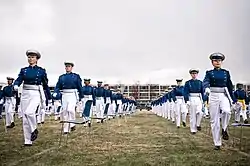
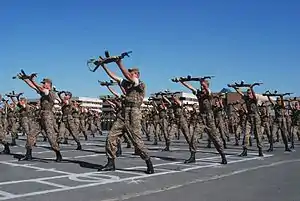
Three types of academy exist: pre-collegiate-level institutions awarding academic qualifications, university-level institutions awarding bachelor's-degree-level qualifications, and those preparing Officer Cadets for commissioning into the armed services of the state.
A naval academy is either a type of military academy (in the broad sense of that term) or is distinguished from one (in the narrow sense). In U.S. usage, the United States Military Academy, the United States Naval Academy, and the United States Air Force Academy serve as military academies under the categorization of service academies in that country.
History
The first military academies were established in the 18th century to provide future officers for technically specialized corps, such as military engineers and artillery, with scientific training.
The Royal Danish Naval Academy was set up in 1701, making it the oldest military academy in existence.[1] The Royal Military Academy, Woolwich was set up in 1741, after a false start in 1720 because of a lack of funds,[2] as the earliest military academy in Britain. Its original purpose was to train cadets entering the Royal Artillery and Royal Engineers. In France, the École Royale du Génie at Mézières was founded in 1748, followed by a non-technical academy in 1751, the École Royale Militaire offering a general military education to the nobility. French military academies were widely copied in Prussia, Austria, Russia and even minor powers, including Turin and the Kingdom of Savoy, in the late 18th century. The Norwegian Military Academy in Oslo, educates officers of the Norwegian Army. The academy was established in 1750, and is the oldest institution for higher education in Norway.
By the turn of the century, under the impetus of the Napoleonic Wars and the strain that the armies of Europe subsequently came under, military academies for the training of commissioned officers of the army were set up in most of the combatant nations. These military schools had two functions: to provide instruction for serving officers in the functions of the efficient staff-officer, and to school youngsters before they gained an officer's commission.[3] The Kriegsakademie in Prussia was founded in 1801 and the École spéciale militaire de Saint-Cyr was created by order of Napoleon Bonaparte in 1802 as a replacement for the École Royale Militaire of the Ancien Régime (the institution that Napoleon himself had graduated from).
The Royal Military College, Sandhurst, in England was the brainchild of John Le Marchant in 1801,[4] who established schools for the military instruction of officers at High Wycombe and Great Marlow, with a grant of £30,000 from Parliament. The two original departments were later combined and moved to Sandhurst.
In the United States, the United States Military Academy (USMA) in West Point, New York was founded on March 16, 1802, and is one of five service academies in the nation.
Types
Pre-collegiate institutions
A military school teaches children of various ages (elementary school, middle school or high school) in a military environment which includes training in military aspects, such as drill. Many military schools are also boarding schools, and others are simply magnet schools in a larger school system. Many are privately run institutions, though some are public and are run either by a public school system (such as the Chicago Public Schools) or by a state.
A common misconception results because some states have chosen to house their juvenile criminal populations in higher-security boarding schools that are run in a manner similar to military boarding schools. These are also called reform schools, and are functionally a combination of school and prison. They attempt to emulate the environment of military boarding schools in the belief that a strict structured environment can reform these children. This may or may not be true. However, their environment and target population are different from those of military schools.[5]
Popular culture sometimes shows parents sending or threatening to send unruly children off to military school (or boarding school) to teach them good behavior (e.g. in the "Army of One" episode of The Sopranos, Tony and Carmela Soprano consider sending their son, AJ, to the Hudson Military Institute; a similar situation appears in Bill & Ted's Excellent Adventure), while other fictional depictions don't show military academies as threats or punishment (e.g. Damien: Omen II and The Presidio).
Adult institutions
A college-level military academy is an institute of higher learning of things military. It is part of a larger system of military education and training institutions. The primary educational goal at military academies is to provide a high quality education that includes significant coursework and training in the fields of military tactics and military strategy. The amount of non-military coursework varies by both the institution and the country, and the amount of practical military experience gained varies as well.
Military academies may or may not grant university degrees. In the US, graduates have a major field of study, earning a Bachelor's degree in that subject just as at other universities. However, in British academies, the graduate does not achieve a university degree, since the whole of the one-year course (undertaken mainly but not exclusively by university graduates) is dedicated to military training.
There are two types of military academies: national (government-run) and state/private-run.
- Graduates from national academies are typically commissioned as officers in the country's military. The new officers usually have an obligation to serve for a certain number of years. In some countries (e.g. Britain) all military officers train at the appropriate academy, whereas in others (e.g. the United States) only a percentage do and the service academies are seen as institutions which supply service-specific officers within the forces (about 15 percent of US military officers).
- State or private-run academy graduates have no requirement to join the military after graduation, although some schools have a high rate of graduate military service. Today, most of these schools have ventured away from their military roots and now enroll both military and civilian students. The only exception in the United States is the Virginia Military Institute which remains all-military.
List of military academies by countries
Afghanistan
.jpg.webp)
- Afghanistan National Army Officer Academy
- National Military Academy of Afghanistan
- Officer Candidate School, Kabul (OCS)
Albania
- Skanderbeg Military University
Angola
- Army Military Academy
- National Air Force Academy
- Naval Academy
Argentina
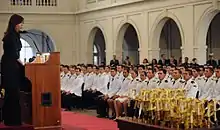
- Colegio Militar de la Nación (National Military College), in El Palomar, Buenos Aires
- Escuela Naval Militar (Naval Military School), in Río Santiago, Buenos Aires
- Escuela de Aviación Militar (Military Aviation School), in the city of Córdoba
Armenia
- Monte Melkonian Military College
- National Institute for Strategic Studies
- Vazgen Sargsyan Military Institute
- Marshal Baghramyan Aviation Academy
- Armenak Khanperyants Military Aviation University
Australia

- Australian Defence Force Academy
- Royal Australian Naval College
- Royal Military College, Duntroon
- Officers' Training School RAAF
Austria
- Theresian Military Academy
- Landesverteidigungsakademie
Azerbaijan
- Schools of the Azerbaijani Armed Forces
- War College of the Azerbaijani Armed Forces
- Azerbaijan Higher Military Academy (formerly the Baku Higher Combined Arms Command School)
- Azerbaijan Higher Naval Academy (former independent institution)
- Azerbaijan High Military Aviation School (former independent institution)
- Special service higher schools[6]
- Academy of the Ministry of National Security
- High Military School of Internal Troops of Azerbaijan
- Police Academy of the Ministry of Internal Affairs
- State Border Service Academy
- Academy of Ministry of Emergency Situations
- Academy of State Customs Committee
Bangladesh

- Armed Forces Medical College[7] (AFMC), Airport Road, Dhaka
Cadet colleges in Bangladesh
Belarus
.jpg.webp)
Belgium
Bolivia
- Military College of Bolivia (Colegio Militar del Ejército de Bolivia)[8]
- Bolivian Military Naval Academy
- Bolivian Air Force Academy
Brazil

Brazil has several military academies:
- Army – The biggest Academy is Academia Militar de Agulhas Negras (AMAN, Military Academy of the Agulhas Negras) in the municipality of Resende, in state of Rio de Janeiro, in the southeast of that country. For high school level, The Sistema Colégio Militar do Brasil (SCMB, Military High School of Brazil System) is composed for 13 military schools in Belo Horizonte, Belém, Brasília, Campo Grande, Curitiba, Fortaleza, Juiz de Fora (MG), Manaus, Porto Alegre, Recife, Rio de Janeiro, Salvador and Santa Maria (RS).
- Navy – Escola Naval (Naval School) was founded in 1823 and is on Villegagnon island, near downtown Rio de Janeiro. The location of the school has historical significance during the French invasions of the then Portuguese Colony in 1555. The Brazilian Navy also prepares students at the High School level at Colégio Naval (Naval High School) in preparation for the Naval Academy (Escola Naval). Colégio Naval was founded in 1876 and is at Enseada Almirante Batista das Neves em Angra dos Reis.
- Air Force – Academia da Força Aérea (AFA, Air Force Academy) and Escola Preparatória de Cadetes do Ar (EPCAr, Air Cadets Preparatory School)
Bulgaria
- Vasil Levski National Military University founded in 1878 as a military school in Plovdiv
- Air Force Faculty in Dolna Mitropoliya
- Artillery, Air Defence and CIS Faculty in Shumen
- All-Force Faculty faculty in Veliko Tarnovo
- Nikola Vaptsarov Naval Academy in Varna and founded in 1881 as Naval Machinery School in Rousse
- Rakovski Defence and Staff College in Sofia, founded with an Act of the 15th National Assembly of March 1, 1912, in Sofia
Canada
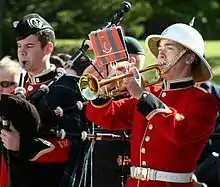
Two post-secondary military academies are operated under the Canadian Military Colleges system, the Royal Military College of Canada (RMCC) in Kingston, Ontario; and the Collège militaire royal de Saint-Jean (CMR) in Saint-Jean-sur-Richelieu, Quebec. RMCC was established in 1876, while CMR was established in 1954.[9] The two institutions provided military education to officer cadets of all three elements in the Canadian Forces; the navy, army and air force; with RMC granted the authority to confer academic degrees in arts, science and engineering by the 1960s.[10] From 1940 to 1995, the Department of National Defence operated a third military college in Victoria, British Columbia, known as Royal Roads Military College.[9]
Graduates of the Colleges are widely acknowledged to have had a disproportionate impact in the Canadian services and society, thanks to the solid foundations provided by their military education.[11] Military discipline and training, as well as a focus on physical fitness and fluency in both of Canada's two official languages, English and French, provided cadets with ample challenges and a very fulfilling experience.[12] In 1995 the Department of National Defence was forced to close RRMC and CMR due to budget considerations, but RMCC continues to operate.[13] RRMC reopened as a civilian university in the fall of 1995, and is maintained by the Government of British Columbia. In 2007, the Department of National Defence reopened CMR as a military academy that offers equivalent schooling as CEGEP, a level of post-secondary education in Quebec's education system.
In addition to Canadian Military Colleges, the Canadian Armed Forces also operate a number of training centres and schools, including the Canadian Forces College, and the Canadian Forces Language School. The components of the Canadian Armed Forces also maintain training centres and schools. The Canadian Army Doctrine and Training Centre (CADTC) is a formation in the Army that delivers combat, and doctrinal training. The CADTC includes several training establishments, such as the Canadian Manoeuvre Training Centre, Combat Training Centre, Command and Staff College, and the Peace Support Training Centre. The 2 Canadian Air Division is the formation responsible for training in the Royal Canadian Air Force (RCAF), and includes establishments like the Royal Canadian Air Force Academy, 2 Canadian Forces Flying Training School, and 3 Canadian Forces Flying Training School. The RCAF also maintains the Canadian Forces School of Survival and Aeromedical Training.
In addition to publicly operated institutions, Canada is also home to one private military boarding school, Robert Land Academy, in West Lincoln, Ontario. Founded in 1978, it is an all-boys' institute that is fully accredited by Ontario's Ministry of Education. The school offers elementary and secondary levels of education, providing schooling for students from Grade 6 to Grade 12.
China, People's Republic of

Colombia
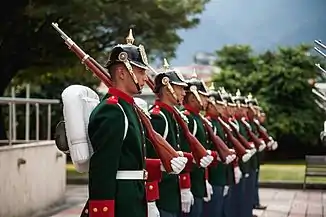
- José María Córdova Military School, in Bogotá.
- Colombian Army NCO School
Colombian Naval Infantry and Colombian Navy:
- Admiral Padilla Naval Academy, in Cartagena de Indias.
- General Santander National Police Academy, in Bogotá.
Czech Republic
- Univerzita Obrany (University of Defence)
- Military academy and training command
Denmark
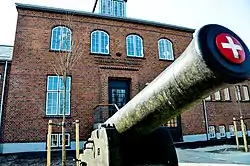
Egypt
- Egyptian Air Defense Academy
- Egyptian Military Technical College
- Egyptian Military medical college
- Egyptian Air Academy
- Egyptian Military Academy
- Egyptian Naval Academy
El Salvador
- Escuela Militar Capitan General Gerardo Barrios
Estonia

Finland

- Finnish National Defence University (Maanpuolustuskorkeakoulu), on Santahamina island, Helsinki
- Maanpuolustusopisto (defunct)
France

High schools
- Lycée militaire de Saint-Cyr
- Lycée militaire d'Autun
- Prytanée National Militaire
- Lycée militaire d'Aix-en-Provence
- Lycée naval de Brest
- École des Pupilles de l'Air
Officer academies

- École spéciale militaire de Saint-Cyr (ESM, literally the "Special Military School of St Cyr") is the French Military Academy. It is often referred to as "Saint-Cyr". Founded by Napoleon in 1802, and initially in Fontainebleau, it was moved first to Saint-Cyr-l'École in 1808, and then to Coëtquidan (Brittany) in 1945.
- École militaire interarmes (EMIA)
- École des commissaires des armées (ECA), founded in 2013
- École de l'air: the French Air Force Academy
- École Navale: the French Naval Academy
- École des officiers de la gendarmerie nationale (EOGN): gendarmerie commissioned officers academy
- École Polytechnique (X): a French engineering grande école of military status. Though all of its French engineering students are enlisted and trained as officers, 5% of its graduates remain in the military after graduation.[14]
- ENSTA Bretagne: a French engineering grande école of military status. Only 1/4 of its students are actual officers-in-training.
- École de Santé des Armées: medical school of French army
- National Military Infrastructure Engineers Academy: trains military engineers of the Armed Forces, opened 2013 (also one of the newest)
Postgraduate academies
- École d'état-major (Staff school): first step of higher military studies, for officer of OF-2 rank.
- École de Guerre (War School): second step of higher military studies, mainly for ranks OF-2 and OF-3 who want to continue the command track (e.g. to command battalion or regiment).
- Collège d'enseignement supérieur de l'armée de terre (Army Higher Education College): second step of military education, but for officers whishing to achieve a high-level specialization.
- Cours supérieur d'état-major (Advanced Staff Course)
- Enseignement militaire supérieur scientifique et technique (Higher Technical and Scientific Education).
- Centre des hautes études militaire (Center for Advanced Military Studies): final step of military education, for very few selected OF-5. Its students also attend the civilian institut des hautes études de défense nationale.
Georgia
- National Defense Academy
- Cadet Bachelor School
- Junior Officer Basic School
- Aviation Air Defense Officer Basic School
- Medical Officer School
- Captain Career School
- Command and General Staff School
- School of Advance Defense Studies
- Language Training School
Germany
.jpg.webp)

Germany has a unique system for civil and military education. The only true military academy is the Führungsakademie der Bundeswehr where mainly future staff officers and general staff officers are further trained.
The standard education in military leadership is the task of the Offizierschulen (officers' schools) run by the three branches. The contents differ from branch to branch. According to the doctrine "leading by task", in the army all prospective platoon leaders are trained down to the level of a commander of a mixed combat battalion. There they also have to pass an officer exam to become commissioned later on.
Moreover, there exist so called Waffenschulen (school of weapons) like infantry school or artillery school. There the officers learn to deal with the typical tasks of their respective corps.
A specialty of the German concept of officer formation is the academic education. Germany runs two Universities of the German Federal Armed Forces where almost every future officer has to pass non-military studies and achieve a bachelor's or master's degree. During their studies (after at least three years of service) the candidates become commissioned Leutnant (second lieutenant).
The three officer's schools are:
- The German Navy supervises:
- The German Army supervises:
- Offizierschule des Heeres, in Dresden
- The German Air Force supervises:
- Offizierschule der Luftwaffe, in Fürstenfeldbruck
Academic and staff education:
Greece

The Hellenic Armed Forces have military academies supervised by each branch of the Armed Forces individually:
- The Hellenic Army supervises:
- The Evelpidon Military Academy, in Athens.
- The Corps Officers Military Academy, in Thessaloniki.
- The Hellenic Air Force supervises:
- The Icarus Air Force Academy, in Tatoi (Athens).
- The Hellenic Navy supervises:
- The Hellenic Naval Cadets Academy, in Piraeus.
Hungary
- National University of Public Service (Successor of Royal Hungarian Ludovica Military Academy, which founded in 1808)
India

- National Defence Academy (NDA)
- Indian Military Academy (IMA)
- Officers Training Academy (OTA)
- Indian Naval Academy (INA)
- Air Force Academy, Dundigul
- Air Force Technical College, Bangalore
Military Schools 1. 5 Rashtriya Military Schools across India in the Belgaum Military School, Bangalore Military School, Chail Military School, Dholpur Military School and Ajmer Military School[16]
- Classes 6 to 12, run by the Integrated Headquarters of Ministry Of Defence (Army) of the Indian government
- Educational institute to train for defence services, no combat training
Indonesia


The Indonesian Military Academy[17] was founded in Yogyakarta, October 13, 1945, by the order of General Staff Chief of Indonesia Army Lieutenant General Urip Sumohardjo as the Militaire Academie (MA) Yogyakarta.
Currently, the Tentara Nasional Indonesia or the TNI (Indonesian National Armed Forces), under the supervision of the Commanding General of the Indonesian National Armed Forces Academy System (a two or three-star officer in billet) in the HQ of the Indonesian National Armed Forces, has divided the academies into the three respective services:
- Indonesian Military Academy (Akademi Militer; Akmil), in Magelang, Central Java, is under the supervision of the Chief of Staff of the Indonesian Army, operated since 1946.
- Indonesian Naval Academy (Akademi Angkatan Laut; AAL), in Surabaya, East Java, is under the supervision of the Indonesian Navy Chief of Staff. The Indonesian Naval Academy also educates and forms officers to serve in the Indonesian Marine Corps. In existence since 1951.
- Indonesian Air Force Academy (Akademi Angkatan Udara; AAU), in Yogyakarta, is under the supervision of the Indonesian Air Force Chief of Staff. The academy has three majorings which are: electronics, engineering, and administration. Following graduation, students who are selected as Pilot and Navigator conduct further training in the Pilot and Navigator Flight School prior bearing the Pilot/Navigator designation. Active since 1945, but also inherits the traditions of former Dutch military aviation schools.
Each service academy is headed by a two-star general who serves as superintendent, and his/her deputy is a one-star officer. All the students (cadets/midshipman) are recruited from senior high school graduates from all over Indonesia. Shortly after graduation, they are commissioned as Letnan Dua (Second Lieutenant/Ensign)) in their respective service branches and get the Diploma IV (Associate degree, 4th Grade) comparable to civil academies or universities. The length term is now 4 years and is divided into five grades of cadets' ranks, starting from the lowest:
- Prajurit Taruna/Kadet/Karbol (Cadet Private), 1st year (4 months)
- Kopral Taruna/Kadet/Karbol (Cadet Corporal), 1st year (8 months)
- Sersan Taruna/Kadet/Karbol (Cadet Sergeant), 2nd year
- Sersan Mayor Dua Taruna/Kadet/Karbol (Cadet Second Sergeant Major), 3rd year
- Sersan Mayor Satu Taruna/Kadet/Karbol (Cadet First Sergeant Major), 4th year
Taruna refers to cadets in the Military Academy, Kadet refers to cadets in the Naval Academy, and Karbol refers to cadets in the Air Force Academy.
Until 1999, before the Indonesian National Police officially separated from the armed forces, the Indonesian Police Academy ("AKPOL") also stood under the National Armed Forces Academy but now has separated from the Military and is under the auspices of the President of Indonesia controlled by the National Police Headquarters (Mabes Polri), where in the other hand the Armed Forces (Army, Naval, and Air Force) Academies of Indonesia is under the auspices of the Ministry of Defense controlled by the Armed Forces General Headquarters (Mabes TNI). Presently, the Police Academy is in Semarang (Central Java), and is supervised under the supervision of the Chief of Indonesian National Police (Kapolri).
All three academies and the Police Academy have a joint 4th class cadet training program since 2008, after completing it the cadets go to their respective academies to continue with the three remaining years of study before commissioning.
As of July 2019, Rear Admiral Aan Kurnia is the Commanding General, INAF Academy System, with Air Vice Marshal Sri Pulung as the assistant commander. The academies system was founded on December 16, 1965.
Iran
Imam Ali Officers' University (Persian: دانشگاه افسری امام علی; acronym:[18] دا اف, DĀʿAF), formerly known as Officers' School (Persian: دانشکده افسری) is the military academy of Ground Forces of Islamic Republic of Iran Army, in Tehran, Iran. Cadets of the academy achieve the second Lieutenant rank upon graduation and join one of Islamic Republic of Iran Army branches.
Italy
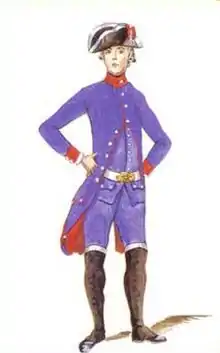
High school level institutions (only for classical and scientific liceum, starting from grade 10):
- Scuola Militare Nunziatella, founded during the Bourbon Period in 1787, in Italian Army, Naples
- Scuola Militare Teulié, founded during the Napoleonic period in 1802, Italian Army, Milan
- Scuola Militare Navale Morosini, Italian Navy, Venice
- Scuola Militare Aeronautica Douhet, Italian Air Force, Florence
2009–2010 school year was the first school year with girls attending.
Non Commissioned Officer (NCO) schools:
- Army: Scuola sottufficiali dell'Esercito Italiano, Viterbo
- Air Force: Scuola sottufficiali della Marina Militare, Taranto and Law Maddalena
- Navy: Scuola marescialli dell'Aeronautica Militare, Viterbo
- Carabinieri: Scuola marescialli e brigadieri dei carabinieri, Firenze
- Guardia di Finanza: Scuola ispettori e sovrintendenti della Guardia di Finanza, L'Aquila
University level institutions:
- Military Academy of Modena
- Scuola di Applicazione, Torino
- Accademia Navale, Livorno
- Accademia Aeronautica, Pozzuoli
- Scuola Ufficiali Carabinieri, Rome
- Accademia della Guardia di Finanza, Bergamo
Japan
- National Defense Academy of Japan (university level)
- National Defense Medical College (medical, university level)
- Officer Candidate Training Schools (for each of Ground, Maritime and Air Self-defense forces)
Kazakhstan

- National Defense University
- Military Institute of the Kazakh Ground Forces (formerly the Alma-Ata Higher All-Arms Command School)
- Talgat Bigeldinov Military Institute of the Air Defence Forces
- Aktau Naval Academy (until 2011)
Cadet Corps
- Astana Zhas Ulan Republican School
- Almaty Zhas Ulan Republican School
- Shymkent Zhas Ulan Republican School
- Karaganda Zhas Ulan Republican School
Korea, North
- Kim Jong-un National Defense University
- Kim Il-sung Military University
- Kim Il-sung Military Political University
- Kim Jong-suk Naval Academy
- Kim Chaek Air Force Academy
Korea, South
.jpg.webp)
The three main military academies:
Other military academies:
- Korea Army Academy at Yeongcheon, formerly Korea Third Military Academy
- Armed Forces Nursing Academy
Kyrgyzstan
- Military Institute of the Armed Forces of the Kyrgyz Republic
- Kyrgyz State National Military Lyceum
- Center for Advanced Training of Officers
Malaysia

Secondary level institutions:
- Royal Military College (Malaysia) (Maktab Tentera Diraja)
University level:
- National Defence University of Malaysia[20] (University Pertahanan Nasional Malaysia) (foundation, bachelor's degree, master's degree, PhD and specialist courses)
- Armed Forces Defence College[21] (Maktab Pertahanan Angkatan Tentera)
Specialist training and staff institutions:
- Officers Cadet School in Port Dickson (OCS)
- Malaysian Armed Forces Staff College[22] (Maktab Turus Angkatan Tentera)
- Armed Forces Health Training Institute[23] (Institut Latihan Kesihatan Angkatan Tentera)
- Malaysian Peacekeeping Training Centre[24] (Pusat Latihan Pengaman Malaysia)
Reserve Officer Training Units (Malay: Pasukan Latihan Pegawai Simpanan or PALAPES) or ROTU exists only in public universities in Malaysia. This is a tertiary institution based officer commissioning program to equip students as officer cadets with military knowledge and understanding for service as Commissioned Officers in the reserve components of the various branches of the Malaysian Armed Forces.
Mexico
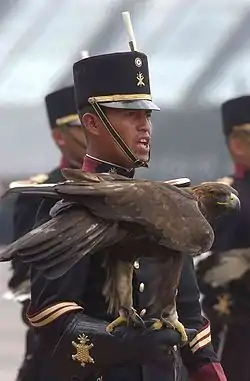
- Heroica Escuela Naval Militar
- Heroico Colegio Militar
- Colegio del Aire
Myanmar
- Defence Services Academy
- Defence Services Technological Academy
- Defence Services Medical Academy
- Officer Training School (Myanmar) (OTS)
- National Defence College (Myanmar) (NDC)
- Defence Services Institute of Nursing and Paramedical Science
Namibia
Netherlands

New Zealand
Tier One – initial officer training
- New Zealand Commissioning Course, Waiouru (NZ Army)
- Initial Officer Training, Woodbourne (RNZAF)
- Officer Training School, Devonport Naval Base
Tier Two – junior officer education
- NZDF Junior Staff Course, New Zealand Defence College
Tier Three – senior officer education
- NZDF Staff Course, New Zealand Defence College
Nigeria

High school training
- Nigerian Military School, Zaria – Nigerian Army military school for boys
- Air Force Military School, Jos, Nigeria, in Jos – Nigerian Air Force military school for boys
- Nigerian Navy Military School, Ikot Ntuen, Akwa Ibom State – Nigerian Navy military School for boys
Undergraduate officer training
- Nigerian Defence Academy, Kaduna – Nigerian Armed Forces university school
Postgraduate officer training
- Armed Forces Command and Staff College, Jaji, at Jaji, Kaduna – joint Nigerian Armed Forces higher studies institute for both indigenous and international students
- Nigerian Army College of Logistics, Lagos – school for training middle career Nigerian Army officers on military logistics
- National Defence College, Abuja – school for training senior officers of the Nigerian Armed Forces and also some members of the civil service
- Army War College Nigeria
Norway

Undergraduate officer training
- Norwegian Military Academy, Linderud/Oslo (Norwegian Army)
- Norwegian Naval Academy, Laksevåg/Bergen (Royal Norwegian Navy)
- Norwegian Air Force Academy, Trondheim (Royal Norwegian Air Force)
Postgraduate training
- Norwegian Defence Staff College, Oslo (joint)
- Norwegian National Defence College, Oslo (civil service/very senior officers)
Pakistan
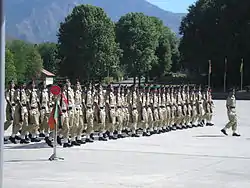
- Pakistan Military Academy, Kakul
- Pakistan Air Force Academy, Risalpur
- Pakistan Naval Academy, Karachi
- Command and Staff College, Quetta
- National Defence University, Islamabad
- Pakistan Navy War College, Lahore
- PAF Air War College, Karachi
- Army Burn Hall College, for boys, Abbottabad
- Army Public College of Management Sciences (public sector)
- Military College Jhelum, Jhelum District
- Military College Murree, Rawalpindi District
- Military College Sui, Dera Bugti District
- PAF College Sargodha
- PAF College Murre Hills
- Cadet College Razmak, Razmak North Waziristan Agency.
- Cadet College Kohat
- Cadet College Wana
- Cadet College Spinkai
- Cadet College Mastung
- Cadet College Petaro, for Pakistan Navy
- Garrison Cadet College Kohat
- Cadet College Skardu
Panama
- Escuela de Policia National Dr. Justo Arosemena[25]
Paraguay
- Francisco López Military Academy, in Capiatá, Paraguay
Peru
Undergraduate officer training
- Chorrillos Military School (Peruvian Army)
- Peruvian Naval School (Peruvian Navy)
- Peruvian Air Force Officers' School (Peruvian Air Force)
- Officers' School of the National Police of Peru (National Police of Peru)
Philippines

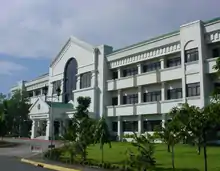
The Philippines patterned all its service academies after the United States Military Academy (West Point) and the United States Merchant Marine Academy (King's Point).
These higher education institutions are operated by the Philippine Government and grant different baccalaureate degrees.
- Philippine Military Academy (Akademiyang Militar ng Pilipinas), City of Baguio – It is the primary training school of the Armed Forces of the Philippines for would be regular commissioned officers of the Philippine Army, Philippine Navy, Philippine Marine Corps and the Philippine Air Force. It is under the control of the Department of National Defense. Its former name was the Philippine Constabulary Academy. During the American colonial rule era, U.S. Army Cavalry Officers established the school for the professionalization of the enlisted personnel of the defunct Philippine Constabulary. It was renamed the Philippine Military Academy before the 1930s. In 1992, PMA stopped providing graduates to the Philippine Constabulary after the passage of Republic Act 6975 which resulted in the merger of the Philippine Constabulary and the Integrated National Police. The merged institutions was named the Philippine National Police. Beginning in 1993, PMA became a co-educational school.
- Philippine Merchant Marine Academy, Zambales – It is a school for students who shall serve in different private shipping companies, foreign or local. Its graduates may serve in the Philippine Coast Guard and the Philippine Navy as an ensign after graduation depending upon their choice. All PMMA graduates are also automatically appointed by the president of the Philippines as ensigns (2nd lieutenants) in the Philippine Navy Reserve. This is the oldest of the Philippine service academies having been established in 1820 during the long period of Spanish colonial rule in the country, and was first situated in Manila for many years.
- Philippine National Police Academy, Cavite – during the 1980s, it served as a school for selected enlisted personnel and civilians who will join as a Police/Fire Lieutenants in the defunct Integrated National Police. After the merging of the Philippine Constabulary and INP on January 1, 1991, it became the primary school supplying officers for the new Philippine National Police, the Bureau of Fire Protection and the Bureau of Jail Management and Penology, all under the Department of the Interior and Local Government. The Philippine National Police Academy graduates are automatically appointed as Lieutenants in the Philippine National Police, Bureau of Fire Protection , and the Bureau of Jail Management and Penology according to their choice of public safety curriculum during their cadetship. This is under the supervision of the DILG and the Philippine Public Safety College.
Aside from the PMA and the PMMA, all three branches of the AFP have their own Officer Candidate Course Programs for both men and women, patterned after their US counterparts.
The nation's higher military colleges are:
- Armed Forces of the Philippines Command and General Staff College, Quezon City – educates officers of the AFP not exceeding the ranks of Colonel or Navy Captain
- National Defense College of the Philippines, Quezon City – is a school for senior AFP officers for military/naval planning and to ready them in holding the ranks of Brigadier General/Commodore. Notable civilians may enroll and be given the honorary rank of Lieutenant Colonel/Commander in the AFP Reserve upon graduation.
Poland

- National Defence University in Warsaw
- Jarosław Dąbrowski Military University of Technology in Warsaw
- Tadeusz Kościuszko Land Forces Military Academy in Wrocław
- Polish Air Force Academy in Dęblin
- Heroes of Westerplatte Naval Academy in Gdynia
- Faculty of Military Medicine of the Medical University in Łódź
Defunct
- Dzerzhinsky Political-Military Academy in Warsaw
- Polish Air Defense Forces Academy
Portugal
.jpg.webp)
Pre-university level institution
- Colégio Militar, Lisbon – military basic and high school
- Instituto dos Pupilos do Exército, Lisbon – vocational education military school
Undergraduate officer training

- Academia Militar, Lisbon and Amadora – Portuguese Army and Republican National Guard university school
- Escola Naval, Almada – Portuguese Navy university school
- Academia da Força Aérea, Sintra – Portuguese Air Force university school
Postgraduate and staff training
- Instituto de Estudos Superiores Militares, Lisbon – joint command and staff college
No longer operational
- Instituto Superior Militar, Águeda – undergraduate school for training NCOs to become officers
- Escola Superior Politécnica do Exército, Amadora – undergraduate school for training NCOs to become officers
- Escola do Serviço de Saúde Militar, Lisbon – Portuguese Armed Forces nurse and paramedic undergraduate school
- Instituto de Odivelas, Odivelas – pre-university level military school for girls
- Instituto de Altos Estudos Militares, Lisbon – Army graduate and staff college
- Instituto Superior Naval de Guerra, Lisbon – Navy graduate and staff college
- Instituto de Altos Estudos da Força Aérea, Sintra – Air Force graduate and staff college
Romania
- Carol I National Defence University (Universitatea Națională de Apărare Carol I), Bucharest
- Technical Military Academy (Academia Tehnică Militară), Bucharest
- Land Forces:
- Air Forces:
- Academia Forțelor Aeriene (Air Forces Academy), Braṣov
- Naval Forces:
Russia
See also: Cadet Corps (Russia), Military academies in Russia
First stage of training
- The Cadet Corps is an admissions-based military middle school for young boys that was founded in the Russian Empire in 1732, soon becoming widespread throughout the country.
- Omsk Cadet Corps
- Karelia Cadet Corps
- Krasnoyarsk Cadet Corps
- Magnitogorsk Cadet Corps
- Georgy Zhukov Moscow Cadet Corps
- Moscow Cossacks Cadet Corps
- Moscow Cadet Corps of Military Music
- Moscow Cadet Corps of the Ministry of Emergency Situations of Russia
- Moscow Diplomatic Cadet Corps
- Moscow Cadet Corps "Heroes of the Battle of Stalingrad"
- St.Petersburg Space Forces Cadet Corps
- St.Petersburg Strategic Rocket Forces Cadet Corps
- St.Petersburg Artillery Cadet Corps
- The 1st St. Petersburg Border guard Cadet Corps of the FSB
- Tambov Cadet Corps
- Toliatti Cadet Corps
- Ufa Cadet Corps
- The Sea Cadet Corps
- Kronstadt S.C.C.
- Moscow Representative Sea Cadet Corps of the Navigation and Mathematics School
- Moscow Sea Cadet Corps Heroes of Sevastopol
Secondary education
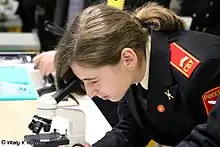
- Suvorov Military Schools are a type of boarding school in modern Russia for boys aged 14–18. Education in such these schools focuses on military related subjects.
- Irkutsk S.M.S.
- Kazan S.M.S.
- Moscow S.M.S.
- Moscow Military Music College
- North Caucasus S.M.S.
- Orenburg S.M.S.
- Perm S.M.S.
- St. Petersburg Space Forces S.M.S.
- Tula S.M.S. (reopening 2016 after 56 years of closure)
- Tver S.M.S.
- Ulyanovsk S.M.S.
- Ussuriysk S.M.S.
- Yekaterinburg S.M.S.
- Nakhimov Naval School is a form of higher naval education for teenagers introduced in modern Russia.
- St. Petersburg N.N.S.
- Murmansk N.N.S.
- Kaliningrad N.N.S
- Sevastopol N.N.S.
- Vladivostok N.N.S.
Post-secondary education


- Combined Arms Academy of the Armed Forces of the Russian Federation
- Gagarin Air Force Academy (now the Gagarin-Zhukovsky Combined Air Force Academy)
- Military Engineering-Technical University
- Saint Petersburg Mining Institute
- Alexander Popov Naval Radio-electronic Academy
- Military Materiel Security Academy
- Pacific Naval Institute
- Moscow Peter the Great Strategic Rocket Forces Academy
- Moscow Higher Military Command School
- Baltic Naval Institute
- Sevastopol Black Sea Higher Naval Institute
- Military University of the Ministry of Defense of the Russian Federation
- Far Eastern Higher Combined Arms Command School
- Budyonny Military Academy of the Signal Corps
- Yekaterinburg Force Command School of Artillery
- Air General Staff Center of Missile and Air Defense Excellence
- Khabarovsk Military Commanders Training Academy
- Civil Defense Academy of the Ministry of Emergency Situations
- Sergey Kirov Military Communications Academy
- S.M. Kirov Military Medical Academy
- St. Petersburg Military College of Physical Fitness and Sports
- Marshal Aleksander Vasilevsky Military Academy of the Armed Forces Air Defense Branch
- Moscow Border Guards Superior College
- Military University of the Ministry of Internal Affairs
Staff college
Serbia

Somalia
- Camp TURKSOM trains both officers and NCOs, offers a two-year course for officers and a one-year course for NCOs.
South Africa
- South African Military Academy provides officers in the SANDF with an opportunity to earn a 3yr BMil degree.
Spain
- Academia General Militar, Zaragoza
- Academia General del Aire, San Javier
- Escuela Naval Militar de Oficiales, Marín
- Escuela Superior de las Fuerzas Armadas
- Academia Central de la Defensa
- Academia de Artillería
- Academia de Infantería
- Academia de Caballería
- Academia de Ingenieros
- Academia de Logística
- Academia General Básica de Suboficiales
- Escuela de Suboficiales de la Armada
- Academia Básica del Aire
- Escuela Militar de Montaña y Operaciones Especiales
Sri Lanka
The General Sir John Kotelawala Defense University, was established in 1980 and is named after Gen. Sri John Kotelawala the 2nd Prime Minister of Sri Lanka. Taking cadets from all three armed services, 3 non-university level Military Academies, one for each armed service providing basic training for officer and a Command and Staff College for senior officers of the three armed services.
Officer training
Staff training
Undergraduate officer training
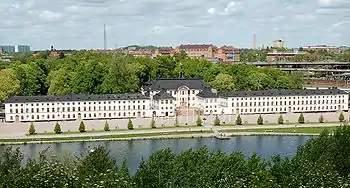
- Military Academy Karlberg, officers
- Military Academy Halmstad, specialist officers (NCO) and reserve officers
Postgraduate training
Taiwan (Republic of China)
- R.O.C. Military Academy
- R.O.C. Naval Academy
- R.O.C. Air Force Academy
- R.O.C. Air Force Institute of Technology
- Army Academy R.O.C.
- National Defense University
- War College
- Army Command and Staff College
- Naval Command and Staff College
- Air Force Command and Staff College
- Institute of Technology
- Management College
- Political Warfare College
- National Defense Medical Center
- Chung-cheng Armed Forces Preparatory School
Tanzania
Thailand
- Armed Forces Academies Preparatory School (secondary level)
- Chulachomklao Royal Military Academy (university level)
- Phramongkutklao College of Medicine (medicine, university level)
- Royal Thai Navy Academy (university level)
- Royal Thai Air Force Academy (university level)
- Royal Thai Police Cadet Academy
- Medicine, University level
- Phramongkutklao College of Medicine
- Royal Thai Army Nursing College
- Royal Thai Navy Nursing College
- Royal Thai Air Force Nursing College
- Royal Thai Police Nursing College
Turkey
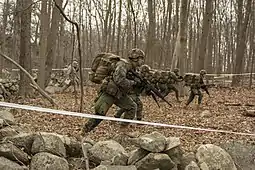
- National Defence University
- Turkish Military Academy
- Turkish Naval Academy
- Turkish Air Academy
- Gendarmerie and Coast Guard Academy
- Camp TURKSOM in Somalia trains both officers and NCOs, offers a two-year course for officers and a one-year course for NCOs. (Turkey operates the academy for Somali officers and NCOs.)
Turkmenistan
.jpg.webp)
- Military Academy of Turkmenistan (founded in 2007)
- Military Institute of the Ministry of Defense of Turkmenistan
- Turkmen State Border Service Institute
- Institute of the Ministry of Internal Affairs of Turkmenistan
- Turkmen National Security Institute
- Turkmen Naval Institute
Uganda
Uganda maintains the followings military training institutions, as of December 2010:[26]
- Bihanga Military Training School – at Bihanga, in Ibanda District, Western Uganda[27]
- Kalama Warfare Training School – at Kabamba, Mubende District[28][29][30]
- National Leadership Institute (NALI) – at Kyankwanzi, Kyankwanzi District
- Oliver Tambo School of Leadership – at Kaweweta, Nakaseke District[31][32]
- Uganda Air Defence and Artillery School – at Nakasongola in Nakasongola District
- Uganda Military Airforce Academy – at Nakasongola in Nakasongola District[33]
- University of Military Science and Technology – at Lugazi, Buikwe District[34]
- Uganda Junior Staff College – at Qaddafi Barracks, Jinja
- Uganda Military Academy – at Kabamba, Mubende District
- Uganda Senior Command and Staff College – at Kimaka, Jinja
- Uganda Urban Warfare Training School – at Singo, Kiboga District[35]
Ukraine
A number of universities have specialized military institutes, such as the Faculty of Military Legal Studies at Kharkiv's National Yaroslav Mudryi Law Academy of Ukraine; however, the primary Ukrainian military academies are the following:[36]
- Hetman Petro Sahaydachnyi Military Academy, Lviv[37]
- Admiral Pavel Nakhimov Naval Academy, Odessa
- Ivan Kozhedub Air Force University, Kharkiv
Staff colleges
Pre-University level institution

- Welbeck Defence Sixth Form College – Sixth form college for 16- to 18-year-olds providing A-Level education in preparation for entry into the British Armed Forces or Ministry of Defence Civil Service as Technical Officers, following undergraduate education sponsored under the Defence Technical Undergraduate Scheme (DTUS). The college is due to close in 2021 after an announcement was made in the House of Commons on March 11, 2019.[39]
- Duke of York's Royal Military School – Military based secondary school in Dover, Kent; students are influenced to join the forces after education, but have no commitment to do so.
There are also numerous Cadet forces that operate for all branches of the armed forces for children aged 10–20. These are not designed to recruit people into the armed forces but rather are simply Ministry of Defence sponsored youth organisations.
Undergraduate service
Although an undergraduate degree is not a prerequisite for Officer training, the majority of potential Officers will have attended University before joining the Armed Forces. At some universities there may be the option for people to join either a University Royal Naval Unit, a University Officer Training Corps (UOTC) or a University Air Squadron, which are designed to introduce students to life in the Forces and show them the careers that are available. People sponsored under the Defence Technical Undergraduate Scheme will join one of the four Support Units attached to universities participating in DTUS. There is a requirement for bursars of DTUS to join the military for three years after completion of their degree, there no requirement for students of any other organisation to join the military after they finish their degree programs; and the great majority have no further contact with the armed forces. Although service with these organisations may give some initial benefit to cadets attending the military colleges/academies, the next stage of the officer training programs assumes no prior military experience/knowledge, and those that did not partake in military activities at university are not disadvantaged.
Officer training

There are now four military academies in the United Kingdom. Although the curriculum at each varies due to the differing nature of the service a man or woman is joining, it is a combination of military and academic study that is designed to turn young civilians into comprehensively trained military officers.
- Britannia Royal Naval College, HMS Dartmouth
- Commando Training Centre Royal Marines
- Royal Military Academy Sandhurst
- Royal Air Force College Cranwell
Officer Training for the Reserve Forces (e.g. Army Reserve, Royal Naval Reserve, RAF Reserves and Royal Marines Reserves) also takes place at the relevant military academies, but under a different curriculum and the courses tend to be concentrated into a much shorter period – a significant amount of the study will be undertaken at the cadet's reserve unit.
Postgraduate and staff training
- Royal College of Defence Studies (mainly for officers of Colonel/Brigadier or equivalent rank selected as future senior leaders; highly selective)
- Joint Services Command and Staff College (courses for officers from Major to Brigadier or equivalent rank)
- Defence College of Management and Technology
- Armed Forces Chaplaincy Centre
- Advanced Research and Assessment Group
- Conflict Studies Research Centre

No longer operational
United States
.jpg.webp)
Introduction
In the United States, the term "military academy" does not necessarily mean a government-owned institution run by the armed forces to train its own officers. It may also mean a middle school, high school, or college, whether public or private, which instructs its students in military-style education, discipline and tradition. Students at such civilian institutions can earn a commission in the U.S. military through the successful completion of a Reserve Officer Training Corps program along with their college or university's academic coursework.
- The term military school primarily refers to pre-collegiate secondary-school-level military institutions, which were more common before the 1970s and 1980s.
- The term military academy commonly refers to a pre-collegiate, collegiate, and post-collegiate institution, especially the U.S. military-run academies.
- The term US military staff colleges refers to separate graduate schools catering to officers on active duty .
Most state-level military academies maintain both a civilian student body and a traditional corps of cadets. The only exception is the Virginia Military Institute, which remains all-military.[40]
Federal service academies
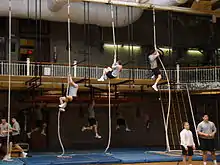
The colleges operated by the U.S. Federal Government, referred to as federal service academies, are:
Post-graduate school
Senior and junior military colleges
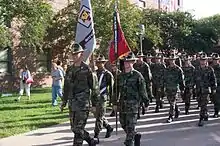

There is one all-military state-sponsored military academy:
- The Virginia Military Institute (VMI), Lexington, Virginia
In addition, these five institutions that were military colleges at the time of their founding now maintain both a corps of cadets and a civilian student body. Many of these institutions also offer on-line degree programs:
- University of North Georgia, Dahlonega, Georgia — Formed by a 2013 merger with Gainesville State College, its main predecessor institution, last known as North Georgia College & State University, was chartered as a military college. However, when NGCSU was founded in 1873 as North Georgia Agricultural College, it had both a corps and a civilian student body, and was also the state's first coeducational college.
- Norwich University Corps of Cadets. Norwich University, Northfield, Vermont is a private university in Northfield, Vermont. It is the oldest private military college in the United States. The university was founded in 1819 at Norwich, Vermont, as the American Literary, Scientific and Military Academy. It is the oldest of six senior military colleges, and is recognized by the United States Department of Defense as the "Birthplace of ROTC"
- Texas A&M Corps of Cadets, Texas A&M University, College Station, Texas
- The Citadel, The Military College of South Carolina, Charleston, South Carolina
- Virginia Tech Corps of Cadets, Virginia Polytechnic Institute and State University, Blacksburg, Virginia
Along with VMI, these institutions are known as the senior military colleges of the US.
Today four institutions are considered military junior colleges (MJC). These four military schools participate in the Army's two-year Early Commissioning Program, an Army ROTC program where qualified students can earn a commission as a Second Lieutenant after only two years of college. The four military Junior jolleges are as follows:
Merchant Marine Academies that have military academy-style operations
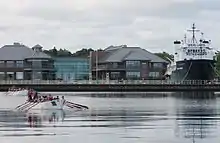
There are six state-operated Merchant Marine academies:
- Massachusetts Maritime Academy
- Maine Maritime Academy
- State University of New York Maritime College (part of the State University of New York (SUNY) system)
- Texas A&M Maritime Academy (part of the Texas A&M University System)
- Great Lakes Maritime Academy (a division of Northwestern Michigan College)
- California State University Maritime Academy (part of the California State University system)
These merchant marine academies operate on a military college system. Part of the training that the cadets receive is naval and military in nature. Cadets may apply for Naval Reserve commissions upon obtaining their Merchant Marine Officer's licenses. Most if not all also offer some form of military commissioning program into the active duty US Navy, US Marine Corps, or US Coast Guard.
Staff colleges
The United States staff colleges, mandated to serve the needs of officers for post-graduate studies and other such graduate institutions as mandated by the Department of Defense are:
United States Air Force Air University attached staff colleges
- The Air University in Maxwell AFB, Alabama, includes:
- Squadron Officer College and Squadron Officer School
- Air Command and Staff College
- Air War College
Staff colleges of the United States Army

Staff colleges of the United States Navy and the United States Marine Corps
Joint Service staff colleges

Other post-graduate colleges operated by the DoD
- National Intelligence University (military intelligence)
- The Judge Advocate General's Legal Center and School (legal services training)
- Air Force Judge Advocate General's School (legal services training)
- Naval Justice School (legal services training)
Uzbekistan

- Academy of the Armed Forces of Uzbekistan (formerly the Tashkent Higher All-Arms Command School)
- Joint Service Officer Training Academy
- Tashkent Higher Tank Command School
- Samarkand Higher Military Automobile Command School
- Higher Military Customs Institute
- Academy of the Ministry of Internal Affairs of Uzbekistan
- Military-Technical Institute of the National Guard of Uzbekistan
- Uzbekistan Air Academy
Vietnam
- National Defense Academy of Vietnam in Hanoi, Vietnam
- Lê Quý Đôn Technical University in Hanoi, Vietnam
- Vietnam Naval Academy in Nha Trang, Khánh Hòa Province, Vietnam
Zimbabwe
- Zimbabwe National Defence University
See also
Further reading
- Cadet, Linton Hall, Linton Hall Military School Memories: One cadet's memoir, Scrounge Press, 2014. ISBN 9781495931963 Memoir of cadet who attended a military school for boys ages 6 to 16.
External links
| Wikimedia Commons has media related to Military academies. |
References
- "Royal Danish Naval Academy". Royal Danish Defence College (in Danish). Retrieved January 7, 2016.
- "Woolwich History". Archived from the original on August 6, 2013.
- Richard A Harmon. "Perspectives in the History of Military Education and Professionalism" (PDF).
- Major-General John Gaspard Le Marchant (1766–1812) Archived March 23, 2012[Date mismatch], at the Wayback Machine Defence Academy
- Linton Hall Cadet, Linton Hall Military School Memories: One cadet's memoir, Arlington, Virginia.: Scrounge Press, 2014 ISBN 978-1-4959-3196-3 describes a military school for boys ages 6–16.
- https://edu.gov.az/en/page/339/13471
- "Archived copy". Archived from the original on July 10, 2012. Retrieved August 2, 2012.CS1 maint: archived copy as title (link)
- "Ejército de Bolivia". www.ejercito.mil.bo.
- H16511 Dr. Richard Arthur Preston "To Serve Canada: A History of the Royal Military College of Canada" 1997 Toronto, University of Toronto Press, 1969.
- 4237 Dr. Adrian Preston & Peter Dennis (Edited) "Swords and Covenants" Rowman And Littlefield, London. Croom Helm. 1976.
- H16511 Dr. Richard Preston "R.M.C. and Kingston: The effect of imperial and military influences on a Canadian community" 1968
- H1877 R. Guy C. Smith (editor) "As You Were! Ex-Cadets Remember". In 2 Volumes. Volume I: 1876–1918. Volume II: 1919–1984. Royal Military College. [Kingston]. The R.M.C. Club of Canada. 1984
- "To Serve Canada: A History of the Royal Military College since the Second World War", Ottawa, University of Ottawa Press, 1991.
- DCOM. "Choix de 4A des promotions précédentes – Orientation 4A". portail.polytechnique.edu.
- "საქართველოს თავდაცვის სამინისტრო". eta.mod.gov.ge. Archived from the original on December 10, 2012. Retrieved September 19, 2012.
- "Rashtriya Military School". www.rashtriyamilitaryschools.in. Archived from the original on November 26, 2016. Retrieved December 19, 2016.
- http://www.akmil.ac.id/
- "اسم هاي مخفف در نيروهاي مسلح". www.parsine.com (in Persian). Archived from the original on September 8, 2016. Retrieved September 11, 2016.
- "Archived copy". Archived from the original on July 27, 2019. Retrieved July 27, 2019.CS1 maint: archived copy as title (link)
- "Portal Rasmi Universiti Pertahanan Nasional Malaysia". www.upnm.edu.my.
- http://maf.mod.gov.my/eng/training_institute/institute02.htm%5B%5D
- "Archived copy". Archived from the original on April 18, 2007. Retrieved May 3, 2007.CS1 maint: archived copy as title (link)
- "Archived copy". Archived from the original on May 3, 2007. Retrieved May 3, 2007.CS1 maint: archived copy as title (link)
- "Archived copy". Archived from the original on May 26, 2007. Retrieved May 3, 2007.CS1 maint: archived copy as title (link)
- http://www.policia.gob.pa/direcciones/dnrrhh/ces.html%5B%5D
- List of Uganda Military Schools Archived February 24, 2015[Date mismatch], at the Wayback Machine
- "1000 TFG Somali soldiers passed out at Bihanga military training".
- "Kalama Warfare Training School Opened in 2005 at Kabamba".
- "Museveni shakes up top army command".
- Kalama Warfare Training School at Kabamba Archived November 2, 2014, at the Wayback Machine
- Oliver Tambo Leadership School at Kaweweta, Nakaseke District Archived September 29, 2011[Date mismatch], at the Wayback Machine
- South Africa Donates Equipment to Oliver Tambo School Archived November 2, 2012, at the Wayback Machine
- "About Uganda Airforce Academy".
- The NUST at Lugazi Archived November 2, 2012, at the Wayback Machine
- About Uganda Urban Warfare Training School Archived February 24, 2015[Date mismatch], at the Wayback Machine
- "Факультет підготовки офіцерів запасу Національний університет оборони України Київський (військова кафедра)". www.nudu.io.ua.
- "History of Academy". Army Academy named after hetman Petro Sahaydachyi. Archived from the original on November 3, 2013. Retrieved July 3, 2013.
- (in Ukrainian) Official website of National Defense University of Ukraine
- Martin, Dan (March 11, 2019). "Shock Government decision to axe Welbeck Sixth Form Defence College, near Loughborough". leicestermercury.co.uk. Leicestershire Live. Retrieved March 11, 2019.
- Standberry, Lee (May 9, 2012). "Top 10 Military Colleges in America". TopTenz.net. Archived from the original on June 24, 2016. Retrieved August 8, 2016.
Unlike other military colleges (the federal service academies), all of VMI's students are members of the Corps of Cadets. This tradition of not offering civilian programs is in keeping with VMI efforts to offer students 'a Spartan, physically and academically demanding environment combined with strict military discipline.'